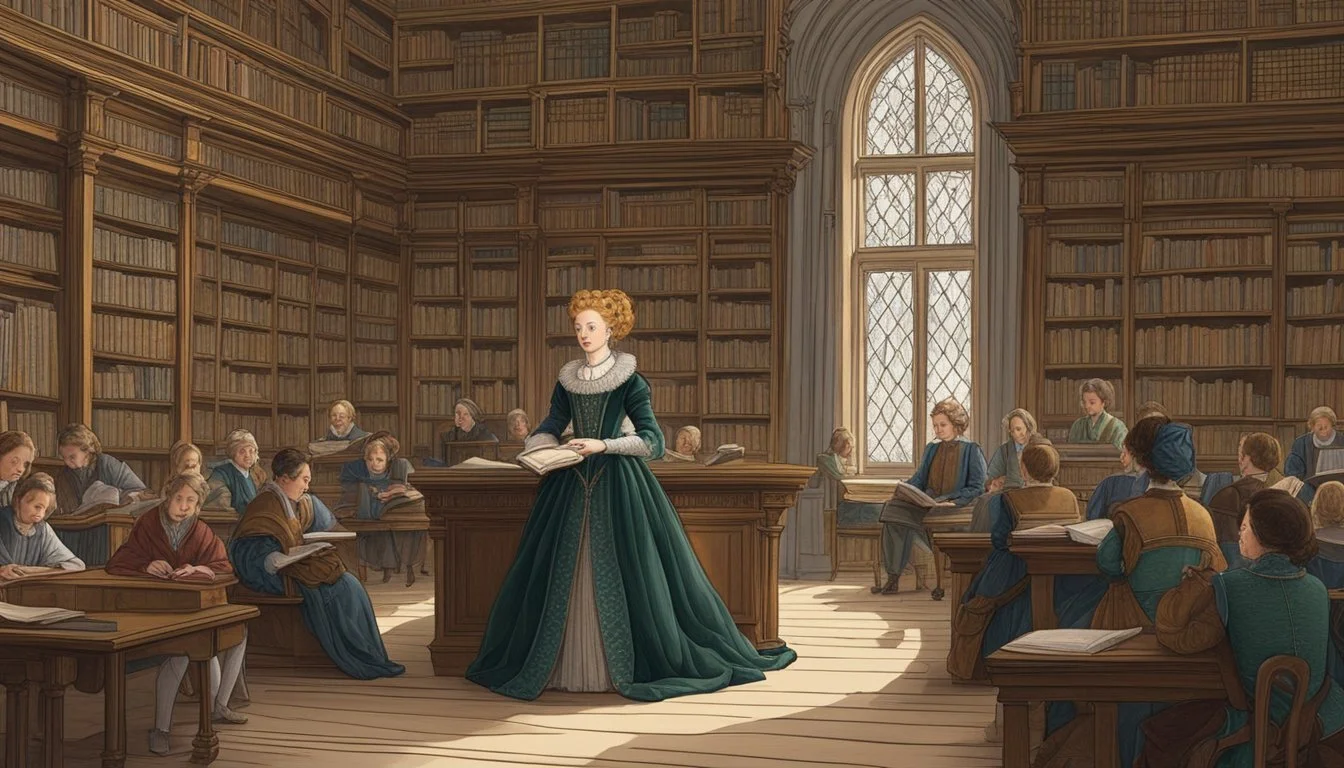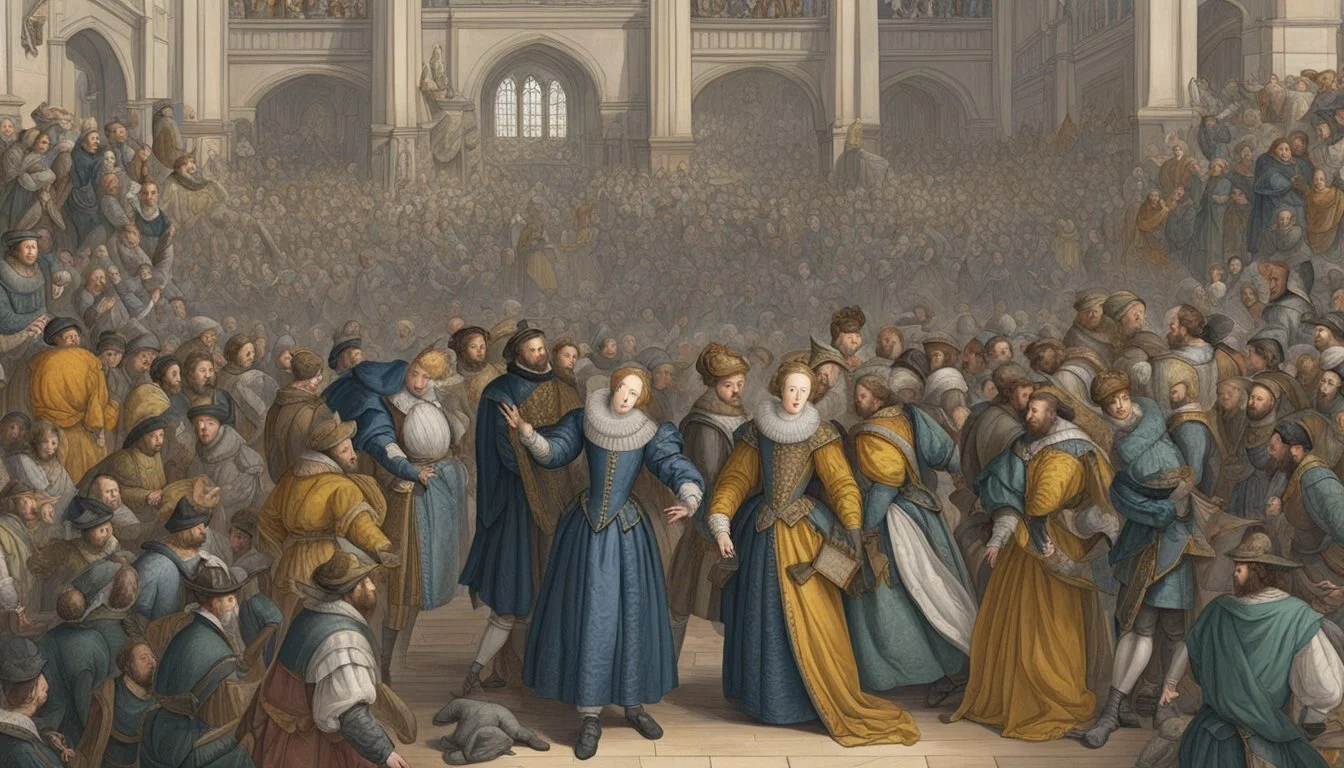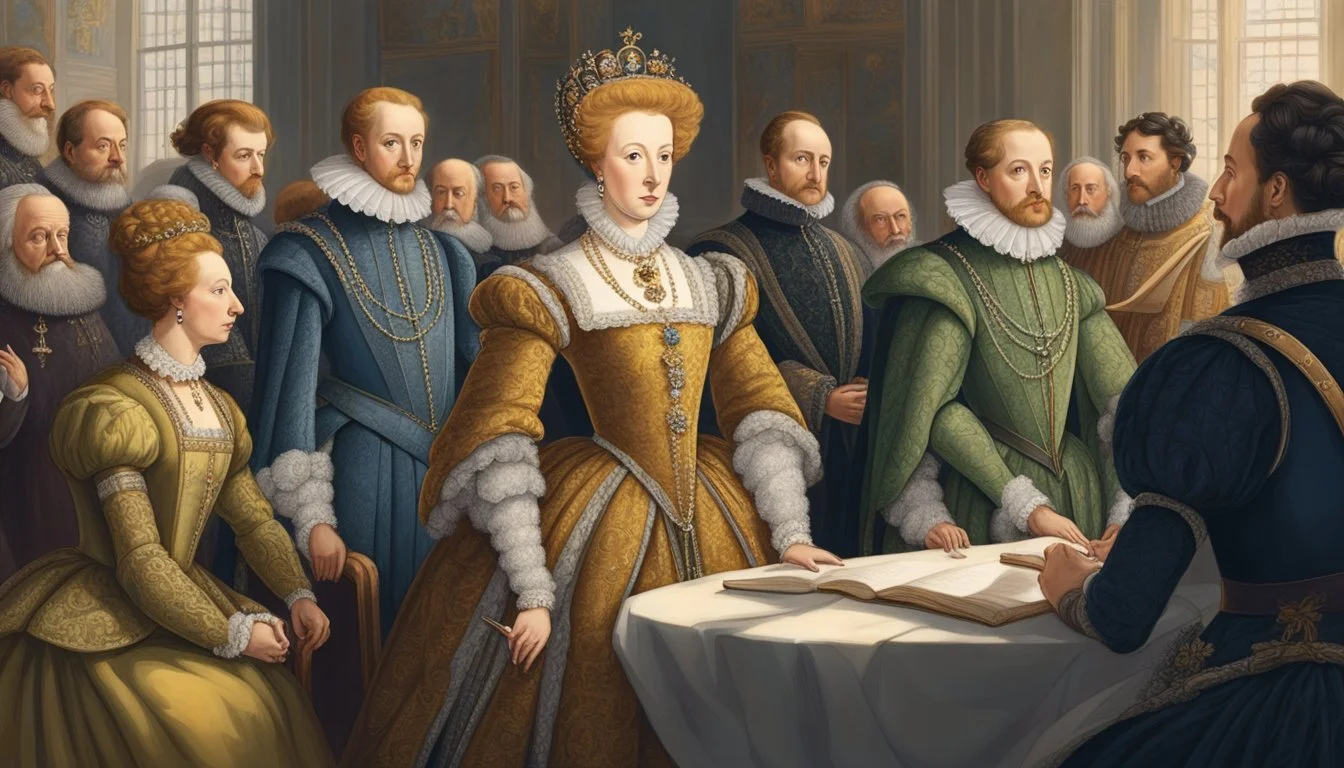Elizabeth I: The Virgin Queen's Early Years
Shaping a Future Monarch
Elizabeth I, born in 1533, emerged as one of England's most influential monarchs. The daughter of Henry VIII and Anne Boleyn, she faced early challenges that shaped her future reign. Her mother's execution and her own disinheritance marked her childhood with uncertainty and peril.
Elizabeth's early years were characterized by a rigorous education and political maneuvering that prepared her for leadership. She excelled in languages, history, and rhetoric, developing skills that would serve her well as queen. Despite the tumultuous environment of the Tudor court, Elizabeth navigated complex relationships and power dynamics with remarkable acumen.
The young princess's path to the throne was far from assured. She survived accusations of treason during her half-sister Mary's reign and emerged as a symbol of Protestant hope. Elizabeth's ascension in 1558 at the age of 25 marked the beginning of a new era for England, one that would come to be known as the Elizabethan Age.
Birth and Lineage
Elizabeth Tudor was born into one of England's most powerful royal dynasties. Her birth and lineage would shape the course of her life and reign as one of England's most influential monarchs.
The Tudor Dynasty
The Tudor dynasty began with Elizabeth's grandfather, Henry VII. He seized the throne in 1485, ending the Wars of the Roses. Henry VII married Elizabeth of York, uniting the houses of Lancaster and York.
Their son, Henry VIII, became king in 1509. He sought to secure the Tudor line with a male heir. This desire would have profound consequences for Elizabeth's mother and the young princess herself.
The Tudors ruled England for over a century. They oversaw significant changes in religion, government, and culture.
Parents and Early Childhood
Elizabeth was born on September 7, 1533, at Greenwich Palace. Her father was King Henry VIII, known for his many marriages and break from the Catholic Church.
Her mother was Anne Boleyn, Henry's second wife. Anne's inability to produce a male heir led to her downfall. She was executed when Elizabeth was just two years old.
After Anne's death, Elizabeth was declared illegitimate. She lost her place in the line of succession and her title of princess.
Despite these setbacks, Elizabeth received an excellent education. She studied languages, history, and theology.
Siblings and the Line of Succession
Elizabeth had two half-siblings:
Mary, daughter of Catherine of Aragon
Edward, son of Jane Seymour
Edward, as the only male heir, became king after Henry VIII's death in 1547. He ruled for six years before dying at age 15.
Mary then took the throne in 1553. Her reign was marked by attempts to restore Catholicism in England.
Elizabeth's position in the line of succession fluctuated throughout her childhood. She went from heir presumptive to illegitimate and back again.
These experiences taught Elizabeth valuable lessons about power and politics. They would serve her well when she finally became queen in 1558.
Elizabeth's Education
Elizabeth I received a rigorous and comprehensive education befitting a Renaissance princess. Her intellect and academic abilities were nurtured from a young age, laying the foundation for her future reign as one of England's most formidable monarchs.
Tutors and Intellectual Development
Roger Ascham, a renowned scholar, served as Elizabeth's primary tutor. He praised her sharp mind and exceptional memory. Under his guidance, Elizabeth developed a love for learning and intellectual pursuits.
Elizabeth's education began at age four. She studied for up to five hours a day, even on holidays. This disciplined approach cultivated her analytical skills and thirst for knowledge.
Her tutors employed innovative teaching methods, emphasizing practical application over rote memorization. This approach helped Elizabeth develop critical thinking abilities that would serve her well as queen.
Languages and Curriculum
Elizabeth mastered multiple languages during her education. She became fluent in Latin, Greek, French, and Italian. Her command of these languages allowed her to converse with foreign diplomats without interpreters.
The curriculum covered a wide range of subjects:
History
Philosophy
Theology
Mathematics
Astronomy
Elizabeth also studied music and excelled at playing the lute and virginals. Her education in rhetoric and oratory prepared her for public speaking, a skill she would use effectively throughout her reign.
Influence of Humanism
Humanist ideals shaped Elizabeth's education. This Renaissance philosophy emphasized the value of classical learning and individual potential. It influenced her worldview and approach to governance.
Humanist teachings encouraged:
Critical thinking
Moral development
Appreciation of art and literature
Elizabeth's education fostered her belief in the power of reason and intellectual discourse. This mindset would later influence her decision-making as queen, as she valued rational debate and sought counsel from learned advisors.
Her humanist education also instilled a sense of duty and public service, preparing her for the responsibilities of rulership.
Religious Upheaval and Early Challenges
Elizabeth I's early years were shaped by religious turmoil and political instability. The young princess faced numerous obstacles as England underwent dramatic shifts in faith and governance.
England's Religious Shift
Henry VIII's break from the Catholic Church in 1534 set England on a tumultuous path. The establishment of the Church of England marked a significant departure from centuries of Catholic tradition. This religious reformation continued under Edward VI, who pushed for more Protestant reforms.
Upon Edward's death in 1553, Mary I ascended the throne. She swiftly reversed her brother's policies, returning England to Catholicism. This abrupt change led to persecution of Protestants and earned Mary the nickname "Bloody Mary."
Elizabeth, raised Protestant, had to navigate these shifting religious tides carefully. Her survival depended on her ability to adapt and avoid controversy during this volatile period.
Catherine of Aragon's Impact
Catherine of Aragon, Henry VIII's first wife, played a crucial role in shaping Elizabeth's early life. Henry's desire to annul his marriage to Catherine led to the break with Rome and the English Reformation.
This decision had far-reaching consequences:
It paved the way for Henry's marriage to Anne Boleyn, Elizabeth's mother
It altered England's religious landscape
It affected Elizabeth's status and upbringing
Catherine's steadfast Catholicism and her daughter Mary's devotion to the faith created a complex family dynamic. Elizabeth had to balance her Protestant upbringing with the Catholic influences around her.
Persecution and Survival
During Mary I's reign, Elizabeth faced significant danger. As a Protestant heir to the throne, she was viewed with suspicion and hostility by Mary's Catholic regime.
Elizabeth's challenges included:
Accusations of involvement in plots against Mary
Imprisonment in the Tower of London
Constant surveillance and scrutiny
To survive, Elizabeth adopted a strategy of outward conformity. She attended Catholic mass and avoided openly challenging her sister's religious policies. This cautious approach allowed her to weather the storm of Mary's reign.
Elizabeth's experiences during this period of religious upheaval and persecution shaped her future policies. They influenced her approach to religious matters once she became queen, leading to a more moderate stance known as the Elizabethan Settlement.
Elizabeth's Path to the Throne
Elizabeth's journey to becoming Queen of England was marked by turbulent events and political intrigue. Her ascension was shaped by the reigns of her half-siblings, her own imprisonment, and the complex question of marriage.
Edward VI's Reign
Edward VI, Elizabeth's half-brother, ascended to the throne in 1547 at the age of nine. During his reign, Elizabeth lived quietly, focusing on her education. She became fluent in several languages and studied history, philosophy, and theology.
Edward's short reign was dominated by Protestant reforms. As his health declined, he attempted to alter the line of succession to exclude his Catholic half-sister Mary.
This move briefly placed Lady Jane Grey on the throne after Edward's death in 1553. However, popular support for Mary led to Jane's deposition after just nine days.
Mary I's Reign and Elizabeth's Imprisonment
Mary I's accession in 1553 brought significant challenges for Elizabeth. As a Protestant, Elizabeth was viewed with suspicion by Mary's Catholic regime.
In 1554, Elizabeth was implicated in Wyatt's Rebellion and imprisoned in the Tower of London. Despite intense questioning, she maintained her innocence and was eventually released.
Elizabeth spent much of Mary's reign under house arrest at Hatfield House. She carefully avoided involvement in political and religious controversies, ensuring her survival during this perilous time.
The Question of Marriage
Elizabeth's marital status became a crucial political issue. As heir presumptive, her choice of husband could significantly impact England's future.
Numerous suitors were proposed, including Philip II of Spain and Robert Dudley. Elizabeth skillfully navigated these proposals, neither committing nor definitively refusing.
Her ability to use the prospect of marriage as a diplomatic tool became evident. This strategy would continue throughout her reign, earning her the moniker "The Virgin Queen."
Elizabeth's unmarried status allowed her to maintain independence and avoid foreign entanglements. It also preserved her image as a ruler wedded to her country rather than a foreign prince.
Interactions with the European Powers
Elizabeth I's early reign was marked by complex relationships with major European powers. Her interactions with France, Scotland, and Spain shaped England's foreign policy and influenced the nation's standing on the international stage.
France and Scotland
Elizabeth faced immediate challenges from France and Scotland upon ascending the throne. Mary, Queen of Scots, posed a significant threat as a Catholic rival with a claim to the English crown. Elizabeth supported Scottish Protestant rebels against Mary's French-backed regime.
In 1560, the Treaty of Edinburgh removed French troops from Scotland. This weakened Mary's position and strengthened Elizabeth's influence. The death of Mary's husband, Francis II of France, further altered the balance of power.
Elizabeth maintained a cautious alliance with France while supporting Protestant factions in Scotland. This strategy helped secure England's northern border and limited French influence in British affairs.
The Spanish Relationship
Philip II of Spain, once married to Elizabeth's half-sister Mary I, initially proposed marriage to Elizabeth. She declined, preserving her independence and England's Protestant reformation.
Spanish-English relations deteriorated over time due to religious differences and maritime conflicts. Elizabeth's support of Dutch rebels against Spanish rule in the Netherlands further strained the relationship.
England's growing naval power and privateering activities against Spanish ships in the New World created additional tensions. These factors set the stage for future confrontations with Spain.
International Influence and Early Reign
Elizabeth's early foreign policy focused on maintaining England's security and independence. She skillfully balanced diplomatic relations with major European powers to avoid isolation or direct conflict.
The queen's religious settlement, establishing a moderate Protestant church, impacted England's international standing. It positioned the nation as a potential ally for Protestant powers while creating tension with Catholic states.
Elizabeth's reputation as an intelligent and capable ruler grew during this period. Her ability to navigate complex international relationships enhanced England's prestige and influence on the European stage.
Ascension to the Throne
Elizabeth I's path to becoming Queen of England was marked by uncertainty and challenges. Her coronation, establishment of governance, and early decisions set the stage for her long and impactful reign.
Elizabeth's Coronation
Elizabeth ascended to the throne on November 17, 1558, following the death of her half-sister Mary I. At 25 years old, she was crowned Queen of England on January 15, 1559, in a grand ceremony at Westminster Abbey. The coronation was a carefully orchestrated event, blending traditional rituals with Protestant elements.
Elizabeth wore a gown of cloth of gold and rode through London in a golden chariot. The streets were lined with cheering crowds, signaling public approval of the new monarch. During the ceremony, she swore oaths to govern justly and defend the Church of England.
Establishment of Governance
Elizabeth quickly assembled a Privy Council of trusted advisors to help her rule. She appointed William Cecil as her Secretary of State, a role he would hold for decades. The new queen also called her first Parliament in 1559 to address pressing matters of state.
One of Elizabeth's first major acts was the passage of the Act of Supremacy, which re-established the Church of England with Elizabeth as its Supreme Governor. This compromise aimed to heal religious divisions in the country.
Elizabeth faced early challenges, including financial troubles and pressure to marry. She skillfully navigated these issues, projecting an image of strength and stability.
The Virgin Queen's Legacy Begins
Elizabeth's early years on the throne laid the foundation for her enduring legacy as the "Virgin Queen." She resisted calls to marry, famously declaring herself "married to England." This decision allowed her to maintain independence and avoid foreign entanglements.
The queen's careful balancing of factions and her political acumen became evident. She cultivated a cult of personality, using her image to inspire loyalty and unity among her subjects. Portraits depicted her as a powerful, almost divine figure.
Elizabeth's early reign saw the beginnings of English exploration and expansion overseas. She supported voyages by explorers like Francis Drake, setting the stage for future colonial ambitions.
Court Life and the Elizabethan Age
Elizabeth I's reign ushered in a period of cultural flowering and political intrigue centered around the royal court. Her court became a hub of artistic patronage, diplomatic maneuvering, and daily rituals that defined the era.
Cultural and Arts Patronage
The Elizabethan Age saw an explosion of artistic achievement. Elizabeth actively supported the arts, sponsoring playwrights, poets, and musicians.
Shakespeare's works flourished under her reign. His plays were performed at court, delighting nobles and diplomats alike.
The Queen's patronage extended to music and visual arts. She employed court composers and maintained a collection of fine paintings and tapestries.
Architecture also thrived, with grand palaces and manor houses built in the distinctive Elizabethan style.
Key Figures at Court
William Cecil, Lord Burghley, served as Elizabeth's chief advisor. His political acumen helped shape domestic and foreign policy throughout her reign.
Robert Dudley, Earl of Leicester, was the Queen's longtime favorite. Their close relationship sparked rumors and political intrigue at court.
Sir Walter Raleigh rose to prominence as a courtier, explorer, and poet. His wit and charm made him a notable figure in Elizabeth's inner circle.
Francis Walsingham, the Queen's spymaster, ran an extensive intelligence network to protect Elizabeth from threats.
Daily Life in the Royal Court
Court life revolved around the Queen's daily routine. Mornings often began with religious services, followed by meetings with advisors.
Afternoons might include audiences with foreign ambassadors or petitioners seeking royal favors.
Evenings featured lavish feasts, music, and theatrical performances. Courtiers vied for the Queen's attention, engaging in witty banter and political maneuvering.
Strict protocols governed behavior at court. Elaborate rituals, such as the ceremonial serving of the Queen's meals, reinforced the monarch's status.
Courtiers' fashion became increasingly ornate, with men and women alike donning elaborate ruffs, jewels, and richly embroidered garments.
Challenges of Rule
Elizabeth I faced numerous obstacles during her reign, testing her leadership and resolve. She confronted threats from various factions, navigated complex religious tensions, and defended England against foreign invasions.
Conspiracies and Plots
Elizabeth's rule was marked by constant threats to her life and crown. Catholic opponents sought to replace her with Mary, Queen of Scots. The Babington Plot of 1586 aimed to assassinate Elizabeth and place Mary on the throne. Sir Francis Walsingham, Elizabeth's spymaster, uncovered this conspiracy.
The Ridolfi Plot in 1571 involved plans to depose Elizabeth and restore Catholicism. These schemes often implicated foreign powers, particularly Spain, in attempts to overthrow the Protestant queen.
Elizabeth's response to these threats was swift and decisive. Many conspirators faced execution for treason, including Mary, Queen of Scots in 1587.
Religious Friction and Politics
Elizabeth's Protestant faith clashed with Catholic interests both at home and abroad. She established the Church of England as a middle ground between Protestantism and Catholicism, but this compromise satisfied neither extreme.
Catholic recusants faced fines and persecution for refusing to attend Anglican services. Meanwhile, Puritan factions pushed for more radical reforms within the Church.
Elizabeth's excommunication by Pope Pius V in 1570 further strained relations with Catholic powers. This religious divide shaped much of her foreign policy and domestic governance.
Military Actions and Defense
The threat of Spanish invasion loomed large during Elizabeth's reign. In 1588, Philip II of Spain launched the Spanish Armada, a massive fleet intended to overthrow the Protestant queen.
Elizabeth rallied her troops at Tilbury, famously declaring, "I know I have the body of a weak and feeble woman, but I have the heart and stomach of a king."
The English navy, led by Sir Francis Drake, defeated the Armada in a stunning victory. This triumph bolstered national pride and Elizabeth's reputation as a strong leader.
England also engaged in naval warfare against Spain in the Americas, with privateers like Drake disrupting Spanish trade routes and raiding colonies.
In Closing: Early Years Legacy
Elizabeth I's formative experiences shaped her into a formidable monarch. Her early trials and education laid the groundwork for her remarkable reign and enduring legacy.
Assessment of Elizabeth's Youth Impact
Elizabeth's tumultuous childhood instilled resilience and political acumen. The young princess navigated court intrigues and religious upheavals, developing a keen sense of self-preservation. Her extensive education under renowned tutors equipped her with linguistic skills and a deep understanding of statecraft.
These early experiences fostered Elizabeth's pragmatic approach to governance. Her ability to balance Catholic and Protestant factions stemmed from her youth, where she learned to adapt to changing religious landscapes.
Elizabeth's early encounters with potential suitors influenced her later stance on marriage. The "Virgin Queen" persona took root in her youth, shaping her future policies and image.
The Foundation of Elizabeth's Reign
Elizabeth's early years laid the groundwork for her successful 45-year reign. Her Tudor lineage and childhood experiences in the royal court prepared her for the challenges of rulership.
The future queen's exposure to diverse religious views in her youth contributed to her later policy of religious tolerance. This approach helped stabilize England after years of sectarian conflict.
Elizabeth's early display of courage and loyalty, particularly during her imprisonment under Mary I, earned her the respect of many subjects. These qualities, honed in her youth, became hallmarks of her reign.
Her education in languages, history, and rhetoric proved invaluable in diplomatic affairs and public addresses. Elizabeth's ability to inspire loyalty and project authority can be traced back to these formative years.






